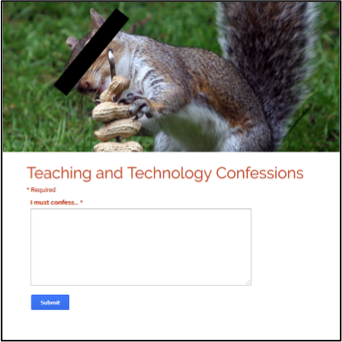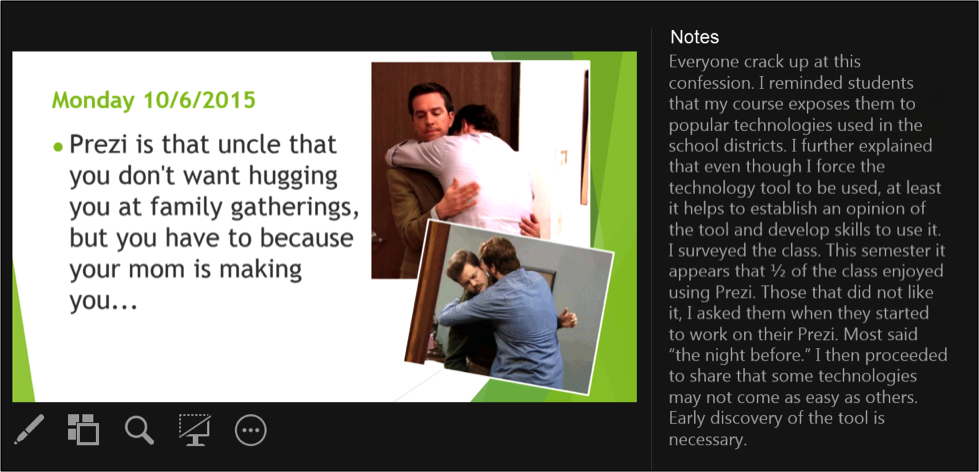University “Confession” Facebook pages or Reddit threads are not new to the world of social media.These public social media sites are an anonymous venue for all to share their experiences at a universityand receive feedback or support from the community without exposing identities. Confessions might be funny in nature…
… Or advice regarding test anxiety…
… Or even relationship decisions …
Unfortunately, loose moderation habits from the administrator can change an engaging idea to inappropriate and offending. But I liked the concept and developed a strategy to successfully incorporate comments and suggestions within university courses as ongoing formative feedback.
My first pilot occurred during the Summer 2015 semester. A gracious and brave instructor (struggling with student feedback and engagement within a graduate course) loved the idea and tried it. Anonymous student comments were shared at the start of each class session to encourage discussion, course modifications, or assignment improvements throughout the semester. Some confessions received:
- “That quiz was too hard.”
- “I loved the game we played on Thursday. I would have stayed for another hour just to play and answer more questions; it was that entertaining! That class left me very optimistic about the rest of the summer.”
- “Applying distributed learning improves studying. Would you be willing to share the final study guide now? The final is just a couple weeks away.”
- “The confession idea is great, all professors should do this.”
The Course Confessions concept was a major success! Students enjoyed the opportunity to share their honest thoughts without concern of an exposed identity. Course Confessions gave the instructor the benefit of addressing student concerns immediately or asking for further clarification without waiting for the generic end-of-the-semester course evaluations to be completed. Having an open and honest conversation with students demonstrated the value of their feedback.
The following semester (Fall 2015), ‘Course Confessions’ was incorporated within an undergraduate course with the same positive experience and has been implemented ever since.
My Strategy
Create a Private/Anonymous Online Form
 Avoid unnecessary attention by removing the public social media venue from the equation. To do that, create a Microsoft form using the UH Office 365 license (with cougarnet credentials), set the settings where “only people in University of Houston can respond” and turn off the option to record name.
Avoid unnecessary attention by removing the public social media venue from the equation. To do that, create a Microsoft form using the UH Office 365 license (with cougarnet credentials), set the settings where “only people in University of Houston can respond” and turn off the option to record name.
Add the form link to the homepage of a Canvas course for easy access for enrolled students.
The form itself simply needs to contain the words “I must confess…” with a text response box and submit button. Keep it simple and inviting.
Notify Students
Inform students of the Course Confession link within the Canvas course and establish ground rules of use. Such as:
- Do not include any identifiers if a confession has to do with a class colleague.
- All confessions must be about the course.
- Confessions will be shared with the class to promote use of the form and discussion opportunities.
- No profanity.
- The instructor reserves the right to remove any identifiers or choose not to share the confession if it is not related to the course.
Review and share confessions
Review confessions to ensure it does not break any established ground rules. If a ground rule is broken, remove the adult language or any identifiers to allow the confession to still be shared with the class.
Create a PowerPoint slide with the confession text and display at the start of class. Read the confession out loud and encourage the class to share any input, feedback, or suggestions. I highly recommend the use of images or memes to keep the class atmosphere light in nature.

Keep notes of class responses
An important teaching practice is to keep records of course improvements or suggestions received throughout the semester. Listen and take notes of your students’ responses to confessions. Review notes to assist in any course modification decisions in the very near future. You might be surprised that students may defend your class often.
Before implementation
- Take confessions in stride. Thick skin, a smile, and a fun professional personality can help relieve any uncomfortable situations. Remember, you might be surprised how often students may defend your class.
- Involve the class regarding workable solutions. Demonstrate that their voice is valued and appreciated.
- End confession discussions on a positive note. It will encourage students to continue the use of Course Confessions – especially when they witness your willingness to hear suggested improvements.
- Take time and search for images or memes that represent the confession. Try to keep the experience fun for students and for yourself.
- Enjoy the humor of your students. Not all confessions will be negative. Confessions may be more of an observation than a confession. Humor in the classroom is one of the easiest ways to keep students engaged.
- Use the same confession form for different sections of the same course. I found it convenient and easier to manage and it provided a sense of relief for students that confessions were also from different sections – creating a more established anonymous atmosphere.
- Course confessions have been implemented in face-to-face and online courses ranging from 7 to 30 students. Auditorium courses will have a larger number of confessions per week. I would recommend combining similar confessions together to save time during class discussions.
Closing Statement
Implementing ‘Course Confessions’ has been one of the most effective methods to increase student feedback and engagement. I share the advice expressed in an online article titled, “Benefits of Talking with Students about Mid-Course Evaluations.” In it, Maryellen Weimer concludes:
… The story students need to hear is one where teacher and students share and respond to feedback that describes how learning is happening in a course. That story begins during the course, not at its end. It solicits descriptive information about specific aspects of the course, not global evaluations. The results are shared, discussed, and acted upon collectively, and now we’re on the way to a story with a happy ending.






